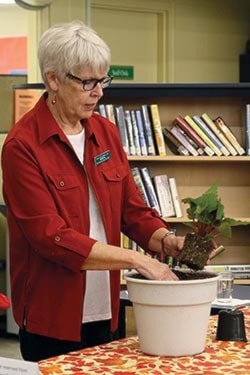No matter what Alberta’s spring weather sends your way, it is never too early to start planning for gardening season.
Organization and preparation were just two of the tips Berta Briggs, founder of Arber Greenhouses Ltd., talked about during a gardening presentation she gave at the Wetaskiwin Public Library on April 25.
Being in the library, with limited space available, Briggs first talked about container gardening before moving to topics such as composting and outdoor beds.
Not limited just to small pots, container gardening has grown to include living walls and rooftop gardening and other innovative ways to flex that green thumb.
As with any gardening, soil quality is important with container gardening. “You want quite a light soil if you’re in a container,” said Briggs.
Gardening soil should not be overly sandy or compacted, as plants need water, oxygen, and organic matter to thrive.
“When it comes to organic matter compost is gold,” said Briggs. Compost can contain a mixture of dirt, yard waste, kitchen waste and animal waste.
Briggs says more successful composters keeps a balance between green and brown matter, as well as churn the compost often.
With the region’s lower temperatures, Briggs says sometimes garden dirt is needed when starting a compost to get the micro-organism bacteria growing. “You need the green and the brown.”
When asked about chicken waste, Briggs told the audience it is a good option for gardens; however, chicken waste needs to age two to three years in compost before being applied to a garden due to how hot it is.
With container gardening, potting soil can be combined with top soil to add nutrients and organic matter. But adding too much will make the soil hard and compact, and insufficient to use for hanging baskets.
Container gardening plants only need about eight to 10 inches of soil for their root systems. If using a larger pot the bottom can be filled with styrofoam or another light packing material. Briggs says this helps keep the container light for mobility and increases drainage for the plant.
To avoid overcrowding in container gardening a gardener’s best course of action is to read the tag stating how much room each plant needs. Briggs says plants are being bred more aggressively than in the past, and therefore need more room to grow without competing with other plants nearby.
“Also, cutting back is so important with container gardens,” said Briggs. Whenever the plants are fertilized a few stems should be trimmed to promote new growth.
When deciding what to plant, whether inside or outdoors, Briggs says there are many options and choices should be considered ahead of time. “Wintertime is the time to do armchair gardening.”
“There’s loads of catalogs, loads of magazines,” she added.
While they can be grown indoors, Briggs says herbs love the sunshine that comes with being grown outside.
Like container gardens, herbs also need regular trims. The trimmings can be dried or frozen in ice cubes or oil cubes for cooking.
Briggs explained root crops such as carrots, turnips, radish and spinach can be planted in the fall for a head start on spring gardening.
Arber Greenhouses annual Ladybug Release Party is scheduled for May 7 at 11 a.m.
